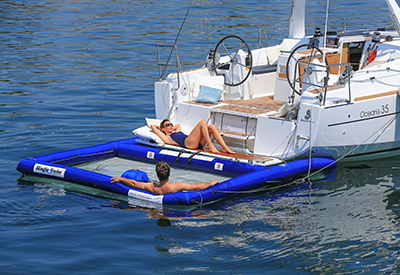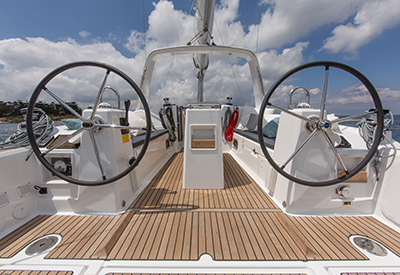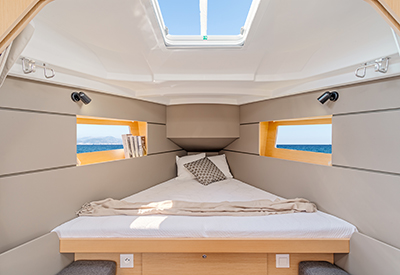Beneteau Oceanis 35
By Robin Ball
In today’s world marketplace choices abound. In some way, every manufacturer tries to make their product unique. They want to provide something to stand out as a reason to choose their product from amongst others in the same category. Adaptability of the interior layout is Beneteau’s latest innovation. It is not a category killer, but the flexibility is appealing. The Oceanis 35 comes in three configurations: Daysailer, Weekender, and Cruiser.
The Daysailer layout is available in a one cabin layout and is well suited to a couple. This layout features an open concept “loft inspired” salon. There is bench seating forward of a sink and fridge on the starboard side and a longer bench to port. The Nav station to port of the companionway is a rear facing desk with the power panel, Fusion stereo system, and B&G V50 VHF. The toilet is starboard at the foot of companionway. There is very large storage area aft on the port side and under the cockpit with another large storage area / lazarette to starboard.
In the Weekender two cabin layout, the port aft storage becomes an athwart ship aft cabin with about 6’4″ of mattress length and the large starboard lazarette remains. A curtain across the V berth in the open salon provides some privacy should there be guests onboard. In the three cabin layout, the space aft of the companionway and under the cockpit is shared equally by two cabins where the mattresses are oriented fore and aft. The main salon remains as an open loft. The Cruiser aft cabin layouts for the two or three cabin layout is as described for the Weekender. In the salon a two burner propane stove and a cabinet are added to the starboard galley in place of the smaller settee. A fold-down salon table and box seat are added to the port side of centre. Replacing the forward privacy curtain is a removable bulkhead which creates a forward cabin. This removable wall allows an owner to reconfigure the interior. For extended trips with friends or with the addition of children, more privacy is created by inserting the bulkhead. To create more openness the bulkhead, the forward box seat and the table can be removed.
 All of these layouts feature a single toilet with electric head, sink, and pull out faucet to create a “wet” shower. An optional separated head is available in the two and three cabin layouts. The hull ports, coach-top side ports and overhead hatches provide natural light to this spacious interior. There are curtains on all of the ports. Large hatches all have retractable blinds and bug screens. The salon hatch just forward of the mast support is equipped with a solar powered ventilator. In our test boat Alpi blond Oak cabinetry, Chine Moka upholstery, a Taupe interior hull liner, and laminate brown Oak cabin sole provide pleasing contrast while maintaining the feeling of openness. LED fixtures are used throughout the boat providing plenty of lighting and energy conservation while on house batteries. A power inverter provides 110 v power when shore power is not available.
All of these layouts feature a single toilet with electric head, sink, and pull out faucet to create a “wet” shower. An optional separated head is available in the two and three cabin layouts. The hull ports, coach-top side ports and overhead hatches provide natural light to this spacious interior. There are curtains on all of the ports. Large hatches all have retractable blinds and bug screens. The salon hatch just forward of the mast support is equipped with a solar powered ventilator. In our test boat Alpi blond Oak cabinetry, Chine Moka upholstery, a Taupe interior hull liner, and laminate brown Oak cabin sole provide pleasing contrast while maintaining the feeling of openness. LED fixtures are used throughout the boat providing plenty of lighting and energy conservation while on house batteries. A power inverter provides 110 v power when shore power is not available.
On deck and in the cockpit the layout is comfortable and efficient. Seating and the cockpit sole are teak as are the toerails, and foot wedges at the helm stations. Cockpit seating is large enough to recline but not to lie down. An optional deluxe cockpit table with storage and folding leaves provides ample port and starboard dining for four. Large side gates in the lifelines and stainless steel handles on the optional arch provide access from the side. Twin wheels, the open transom and optional drop swim platform provide easy aft access to the cockpit. The platform is easily raised and lowered using the attached boarding ladder as a handle.
The arch provides for the mainsheet traveller to be raised out of the cockpit. At 5’9″ above the cockpit the mainsheet is significantly shortened, increasing control on the position of the boom while freeing space within the cockpit. The mainsheet is controlled from the port side coachtop.
All halyards run to the aft of the coach roof. A self tacking jib with a foredeck traveller is optional. The winches controlling the genoa or the optional asymmetrical spinnaker are located within reach of the helm stations or the cockpit benches. Genoa cars on the side decks for conventional sheeting are adjustable from the cockpit. Full instrumentation, GPS and autohelm are provided through a B&G system at the port helm. A second compass and secondary instrument display are at the starboard helm. The engine and anchor windlass controls are at the port helm station.
 Our test boat was a shallow draft 4′ 9″ ( 1.45m) two cabin Cruiser with the forward bulkhead installed. The suggested retail price of this boat as equipped is CAD $245,000 ex. Port Credit.
Our test boat was a shallow draft 4′ 9″ ( 1.45m) two cabin Cruiser with the forward bulkhead installed. The suggested retail price of this boat as equipped is CAD $245,000 ex. Port Credit.
Our test sail was conducted in almost perfect cruising conditions; 9 to 15 knots of wind and 1+ foot wave heights on a hot summer morning. The Yanmar 30 diesel sail drive moved us along smartly at 6 knots at a comfortable high of 3000 rpm. The in-mast furling made mainsail deployment and subsequent furling a one person operation from the safety of the cockpit. Genoa deployment was easily handled at the helm as was sheeting in the 103% Genoa. The sail plan on the Oceanis 35 is almost evenly balanced between the main 297 sqft ( 27.52 sqm) and genoa 288 sqft (26.72 sqm). The boat is designed with a hard chine running above most of the length of the 31′ 10″ (9.70m) waterline. On a close hauled course, with a true wind of 9 knots, the boat very easily attained 6 knots of speed. The chine and the very generous 12′ 2″ (3.72m) beam running from mid-ship to the stern combine to create exceptional stability. The heel was less than 10 degrees under full sail. The twin rudders on such a wide beamed boat ensure that one rudder is always fully in the water. The steering, although responsive to course changes, was so balanced that there was no feel to the helm. The boat was balanced and tracked straight with no hands on the wheel. There was no weather helm at all. On a beam reach with 13 knots true wind we reached 7.3 knots of speed, and on a broad reach of about 75 degrees off a true wind of almost 15 knots we managed 5.3 knots of speed. All of this was achieved without any sail tweaking. Overall the boat handing was responsive and comfortable.
 The Oceanis 35 is a comfortable coastal cruiser ideally suited to the casual sailor. It has a good degree of performance with modern styling, materials and construction. The versatility of the interior space can be adapted to allow for a variety of lifestyles as the needs of its owner change. This versatility would allow the space for daysailing and some club racing. Inserting the bulkhead, table and seat would return the boat to a weekend or holiday cruiser.
The Oceanis 35 is a comfortable coastal cruiser ideally suited to the casual sailor. It has a good degree of performance with modern styling, materials and construction. The versatility of the interior space can be adapted to allow for a variety of lifestyles as the needs of its owner change. This versatility would allow the space for daysailing and some club racing. Inserting the bulkhead, table and seat would return the boat to a weekend or holiday cruiser.
Originally published in Canadian Yachting’s October 2016 issue.
Specifications
Naval Architects – Finot – Conq
Interior Design – Nauta Design
Daysailer Length Overall – 9.97 m – 32’9’’
Weekender & Cruiser Length Overall – 10.45 m – 34’3”
Hull Length – 9.97 m – 32’9”
LWL – 9.70 m – 31’10”
Hull Beam – 3.72 m – 12’2”
Daysailer – Gte Lightweight – 5,207 kg – 11,476 lbs
Cruiser – Gte Lightweight – 5,533 kg – 12,195 lbs
Deep Draught (Min) – 1.85 m – 6’1”
Deep Ballast Weight – 1,559 kg – 3,436 lbs
Shallow Draught (Min) – 1.45 m – 4’9”
Shallow Ballast Weight – 1,825 kg – 4,022 lbs
Drifter draught – 1.15 m / 2.30 m – 3’9” / 7’7”
Drifter Ballast – 1 ,995 kg / 4,397 lbs
Air Draught – 15.45 m – 50’8”
Fuel Capacity – 130 l – 34 US gal
Freshwater Capacity (Standard) – 130 l – 34 US gal
Freshwater Capacity (Optional) – 200 l – 53 US gal
Engine Power – 20 HP/CV – 30 HP/CV
EC Certificate – A6 / B8 / C10
Mainsail (Classic) – 27.50 m2 – 297 sq ft
Genoa (103%) – 26.72 m2 – 288 sq ft
Asymmetric Spinnaker – 83.45 m2 – 898 sq ft
Code 0 – 50.9 m2 – 548 sq ft
Tacking Jib – 25.5 m2 – 274 sq ft
Photo Captions:
Photo 1 – The hard chine and wide beam extend the space within the boat while enhancing performance and stability.
Photo 2 – Private pool.
Photo 3 – Dual wheels; superior control.
Photo 4 – Oceanis 35 Cruiser – forward stateroom.
Photo credits: Beneteau






















